Air Canada's Aeroplan program is one of the most popular loyalty programs in Canada and the United States. With over 45 airline partners with which you can redeem points and an abundance of ways to boost your balance, an Aeroplan account is a must-have for any Miles & Points enthusiast. Here's your complete guide to understanding everything you need to know about earning and redeeming Aeroplan points, with links to key articles for your reference along the way.
Earning Aeroplan Points
As one of the dominant North American rewards programs, Aeroplan makes it very easy for members to earn points.
Canadian Credit Cards
One of the easiest ways to earn Aeroplan points is by earning American Express Membership Rewards points and transferring them to Aeroplan at a 1:1 ratio.Transfers are quick and painless, and the ease with which you can amass MR points makes earning lots of Aeroplan points an equivalently simple task.The secret here lies in the category earning bonuses on American Express cards, which are amongst the best in the business. Depending on the card, you'll receive anywhere from 2–5 Amex MR points per dollar spent on common purchases such as gas, groceries, travel, restaurants, and more.For example, the American Express Cobalt Card earns 5 Amex MR points per dollar spent at grocery stores, restaurants, and bars. Since groceries make up a large portion of every budget, you can quickly watch your points balance grow with each trip to the store.Another reason why American Express cards are key to racking up Aeroplan points is that the cards often come with very competitive welcome bonuses. Earning points through welcome bonuses is by far the fastest and easiest way to earn points, and if you hold out for the right offer, it can easily justify paying a hefty annual fee.The following American Express cards earn MR points that can be transferred to Aeroplan at a 1:1 ratio.In Canada, there are no fewer than 11 Aeroplan co-branded credit cards that are issued by TD, CIBC, and American Express.There are entry-level, mid-tier, and premium cards to choose from, as well as credit cards for small business owners. With so many options to choose from, there should be an Aeroplan card that's suitable for almost everyone.Depending on the card, you'll also enjoy elevated category earning rates on a variety of purchases, including Air Canada, groceries, gas, travel, dining, and food delivery.If you can time your application with a juicy welcome bonus, you can also pad your Aeroplan balance very quickly.Having a co-branded credit card is also a great way to score additional perks, such as a free checked bag on Air Canada flights, preferred pricing on Aeroplan redemptions, ensuring that your points never expire, and more.Here's a full list of Aeroplan co-branded credit cards in Canada, along with the current welcome bonuses and the corresponding annual fees.If you're stuck between an Amex MR card or an Aeroplan co-branded credit card, consult the below articles for more detailed comparisons.US Credit Cards
In the United States, there are a number of ways to access Aeroplan.When it comes to transferable points currencies, there are currently three points programs that can transfer to Aeroplan at a 1:1 ratio:Each bank has a variety of cards with which you can earn points, and then transfer them instantly to Aeroplan. You should also keep an eye out for transfer bonuses that pop up from time to time, which is something not seen in Canada.Chase also has the Chase Aeroplan Card, which is currently the sole US-issued Aeroplan co-branded credit card. As a Mastercard product, it has wider acceptance than American Express worldwide, and also has a competitive earning structure:- 3 Aeroplan points per dollar spent on dining, takeout, and food delivery services worldwide
- 3 Aeroplan points per dollar spent on groceries worldwide
- 3 Aeroplan points per dollar spent on Air Canada and Air Canada Vacations purchases
- 1 Aeroplan point per dollar spent on all other purchases
Buying Aeroplan Points
Aeroplan sells points at a base rate of 3.5 cents per point; however, there are frequent sales that offer either a bonus or a discount on points purchases.In some cases, the sales lower the cost of buying Aeroplan points to 1.6–2 cents per point, which is when it's worth considering.It's worth noting that buying points speculatively isn't generally a good idea. On the other hand, if you need to top up your balance for a redemption, or if you stand to benefit from a significantly reduced price to the cash price of a ticket, buying Aeroplan points can be a good idea.Earning Aeroplan Points by Flying
You can also earn Aeroplan points by flying with Air Canada, Star Alliance airlines, and other non-alliance partners.The rate at which you earn points depends on a number of factors, including the type of fare you purchase, the class of service, and the distance flown, amongst others.Generally speaking, you'll earn more points as you move up the fare types. If you have Aeroplan Elite Status, you can also benefit from bonus points as one of your Select Benefits.The full breakdown of earning Aeroplan points on Air Canada flights, as well as on flights with partner airlines, can be found on the Air Canada website.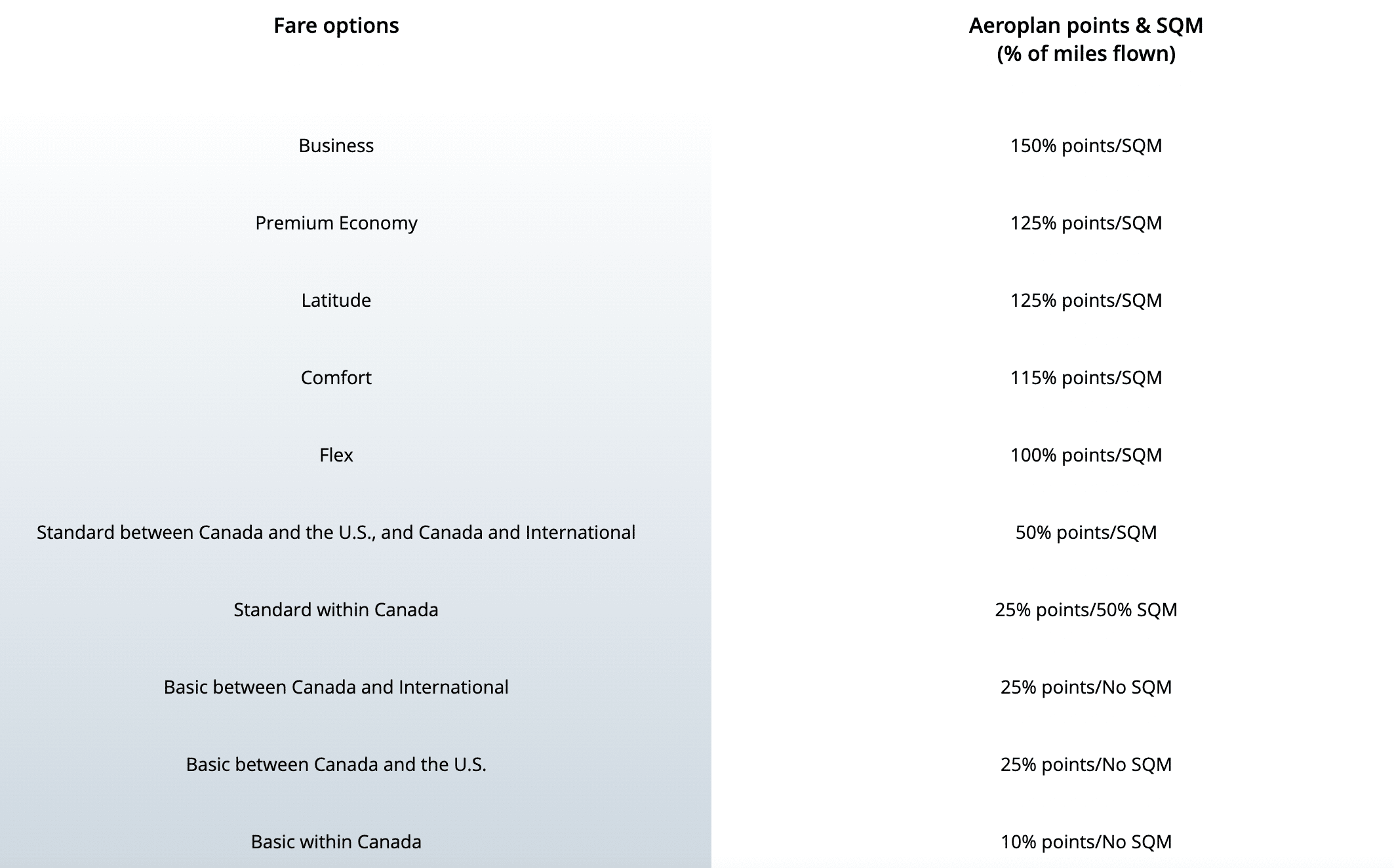
Earn Aeroplan Points on Everyday Purchases
Aeroplan has also partnered with a number of retailers, which makes earning Aeroplan points on everyday purchases even easier.For online shopping, be sure to check out the Aeroplan eStore, which is the program's shopping portal. By simply initiating a shopping session in the portal, you can earn up to 10 Aeroplan points per dollar spent.Your best bet is to wait for promotion, such as Black Friday or Boxing Day, as this is when we tend to see the best available offers on the eStore.Aeroplan has also partnered with Uber and Uber Eats, which means you can earn Aeroplan points on rides and food delivery.Other Ways to Earn Aeroplan Points
In addition to the aforementioned methods, you can also earn Aeroplan points by crediting hotel stays and car rentals to your Aeroplan account instead of to the other program. The full list of available partners can be found on the Air Canada website.You'll just want to be sure to compare the earning rates to make sure you're getting the best deal for your stay or car rental.Lastly, you can earn Aeroplan points by making a booking with Air Canada Vacations. Make certain to pay with an Aeroplan co-branded credit card to get the best bang for your buck.Redeeming Aeroplan Points
Once you’ve earned your Aeroplan points, redeeming points for flights is where the fun begins.Every potential redemption begins with the Aeroplan Flight Reward Chart, which splits the world into four separate zones: North America, South America, Atlantic, and Pacific. This results in there being 10 separate award charts for travel within each zone and between each possible combination of zones.There's also a separate award chart for redemptions with Emirates, which became an Aeroplan partner in late 2022.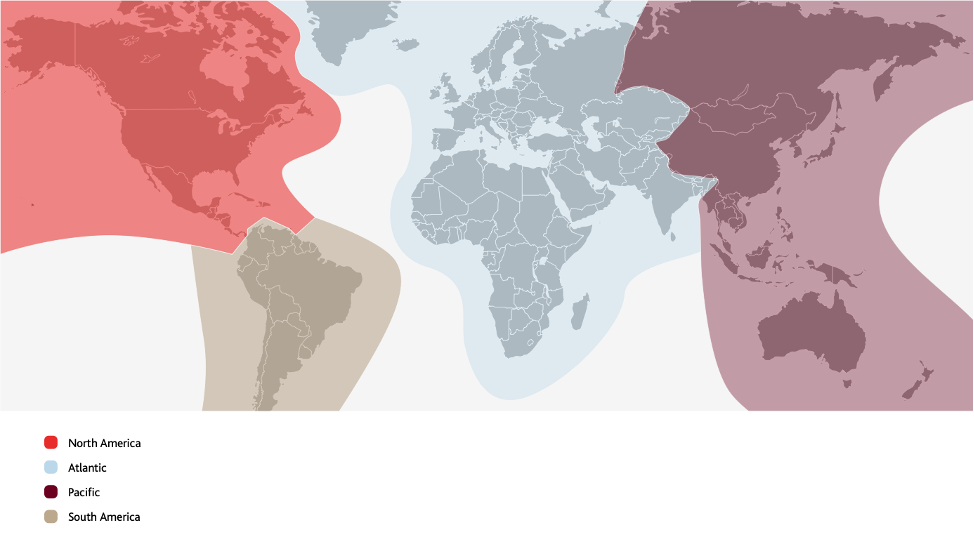 Below are the charts showing the one-way mileage requirements for flights from North America. For round-trip pricing, simply double the amount required.Here's the chart for "Within North America zone":
Below are the charts showing the one-way mileage requirements for flights from North America. For round-trip pricing, simply double the amount required.Here's the chart for "Within North America zone":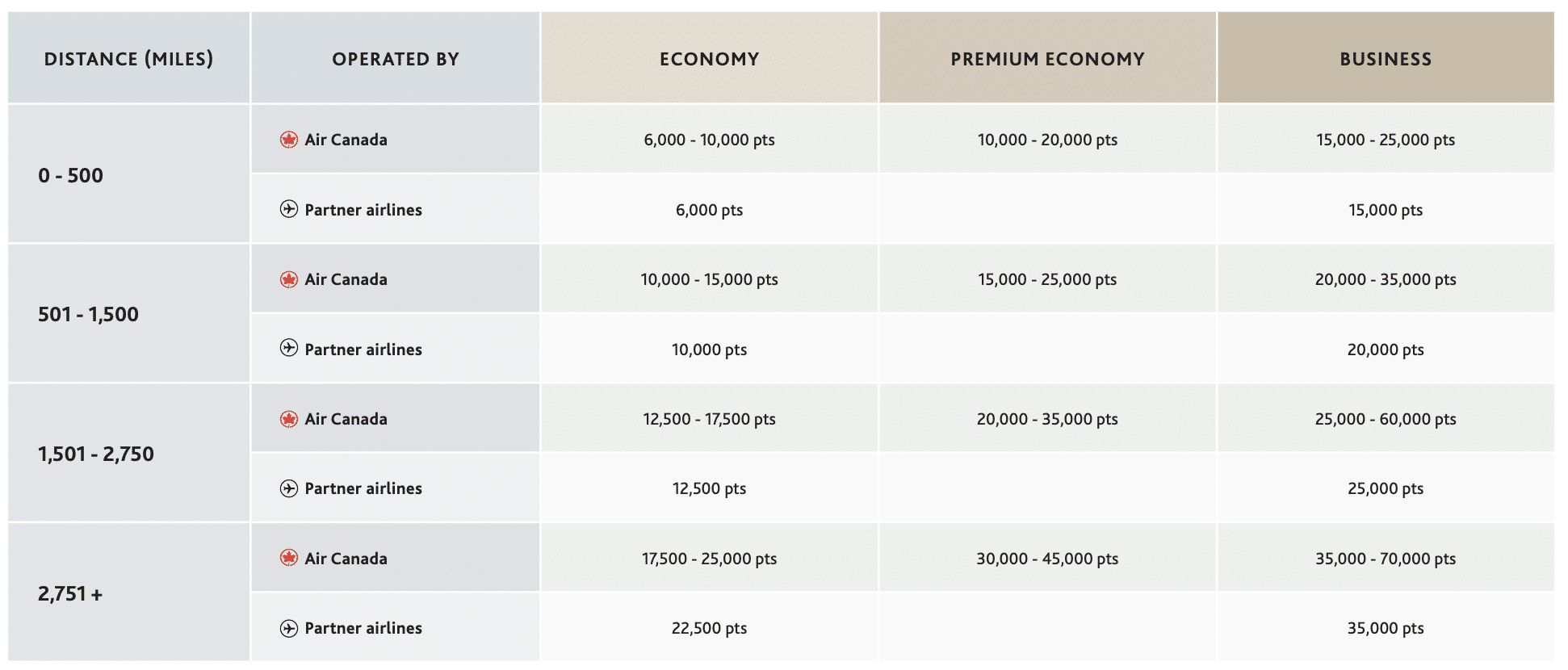 Here's the chart for "Between North America and South America":
Here's the chart for "Between North America and South America":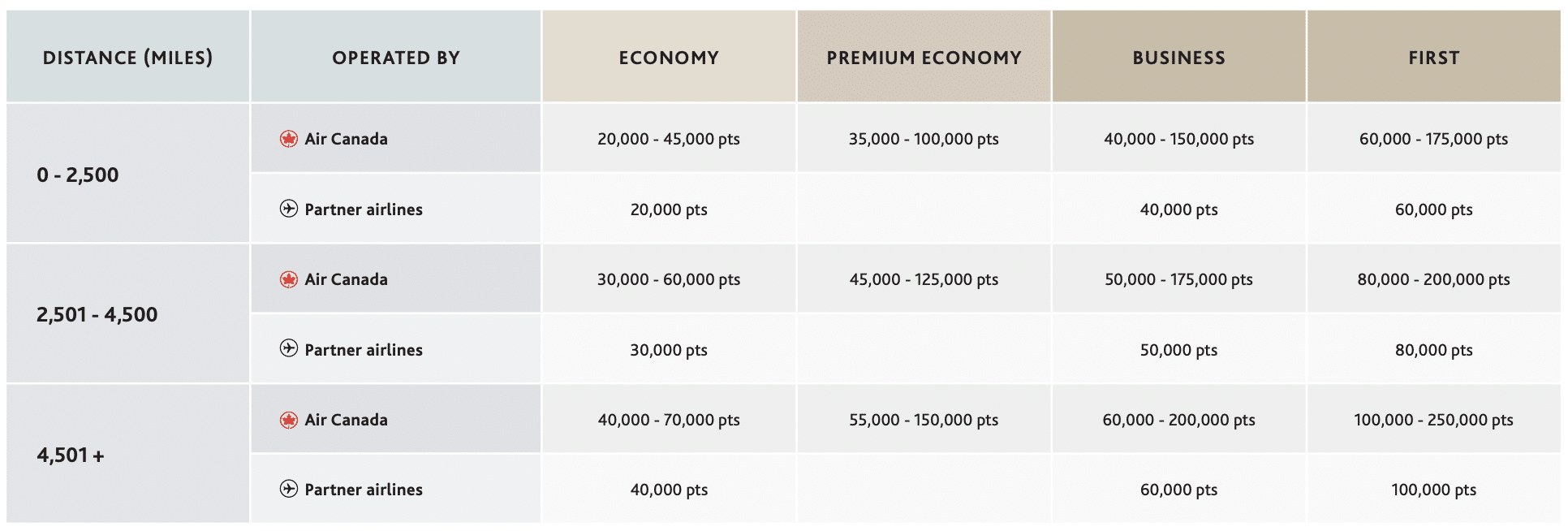 Here's the chart for "Between North America and Atlantic zones":
Here's the chart for "Between North America and Atlantic zones": And here's the chart for "Between North America and Pacific zone":
And here's the chart for "Between North America and Pacific zone":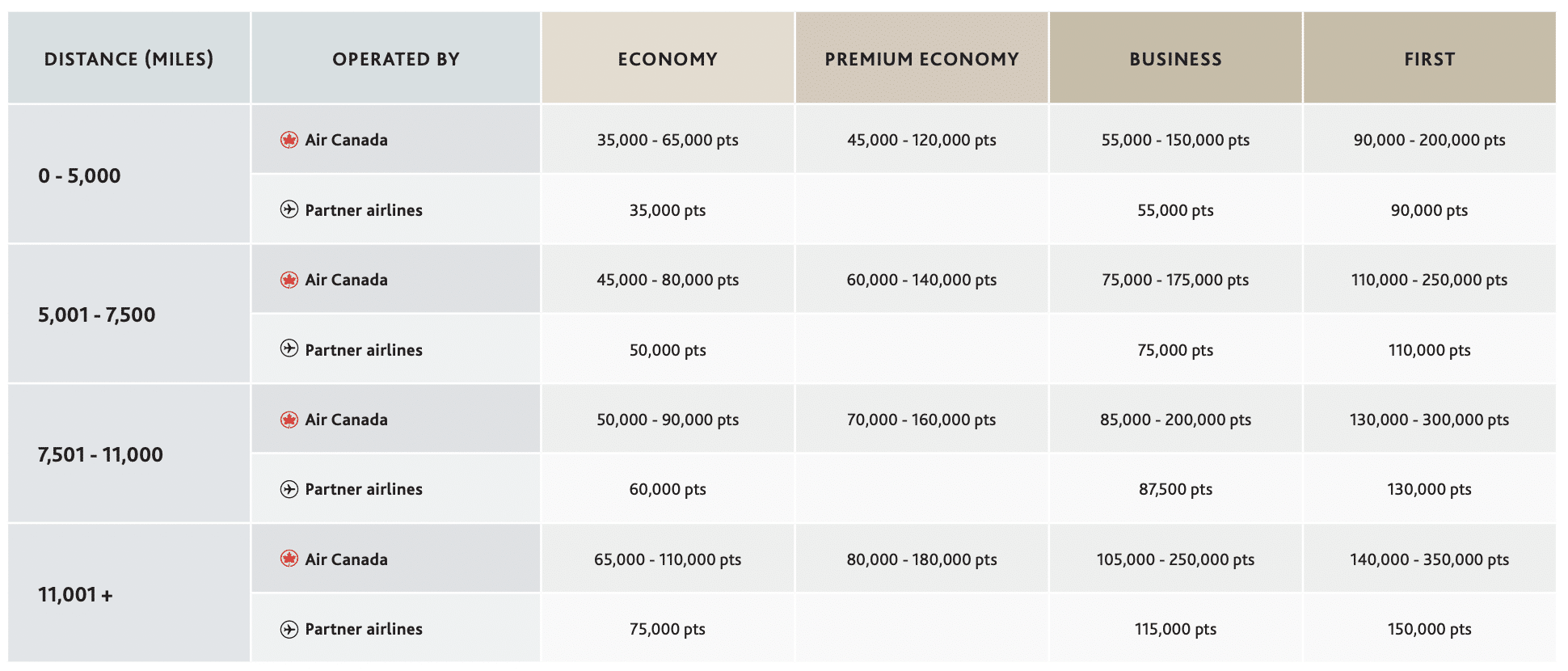 You’ll notice the Flight Reward Chart is a hybrid chart based on the travel zones (i.e., Between North America and Pacific zones"), the class of service (i.e., economy, premium economy, business class, or First Class), and distance-based thresholds.Furthermore, while partner-operated flights are priced at a fixed level, Air Canada flights are priced based on a dynamic pricing model, and the pricing can land anywhere in the published ranges based on the underlying cash fare.Indeed, understanding the distinction between dynamic pricing on Air Canada flights and fixed pricing on partner airlines is a key component of maximizing Aeroplan.As a general rule, if you can get an Air Canada flight at the lower end of the dynamic spectrum or for around the same cost as a partner airline, you know you're getting a good deal. On the other hand, if the pricing is at or above the upper threshold of the dynamic spectrum your best bet is to look for partner airlines or get creative with your routing, so as to avoid paying more than you should.In order to price out a redemption, first determine the correct zones based on your origin and destination, and then head over to Great Circle Mapper to determine the distance between your origin and destination cities.For example, a Toronto–Vancouver domestic flight clocks in at 2,085 miles in distance.
You’ll notice the Flight Reward Chart is a hybrid chart based on the travel zones (i.e., Between North America and Pacific zones"), the class of service (i.e., economy, premium economy, business class, or First Class), and distance-based thresholds.Furthermore, while partner-operated flights are priced at a fixed level, Air Canada flights are priced based on a dynamic pricing model, and the pricing can land anywhere in the published ranges based on the underlying cash fare.Indeed, understanding the distinction between dynamic pricing on Air Canada flights and fixed pricing on partner airlines is a key component of maximizing Aeroplan.As a general rule, if you can get an Air Canada flight at the lower end of the dynamic spectrum or for around the same cost as a partner airline, you know you're getting a good deal. On the other hand, if the pricing is at or above the upper threshold of the dynamic spectrum your best bet is to look for partner airlines or get creative with your routing, so as to avoid paying more than you should.In order to price out a redemption, first determine the correct zones based on your origin and destination, and then head over to Great Circle Mapper to determine the distance between your origin and destination cities.For example, a Toronto–Vancouver domestic flight clocks in at 2,085 miles in distance.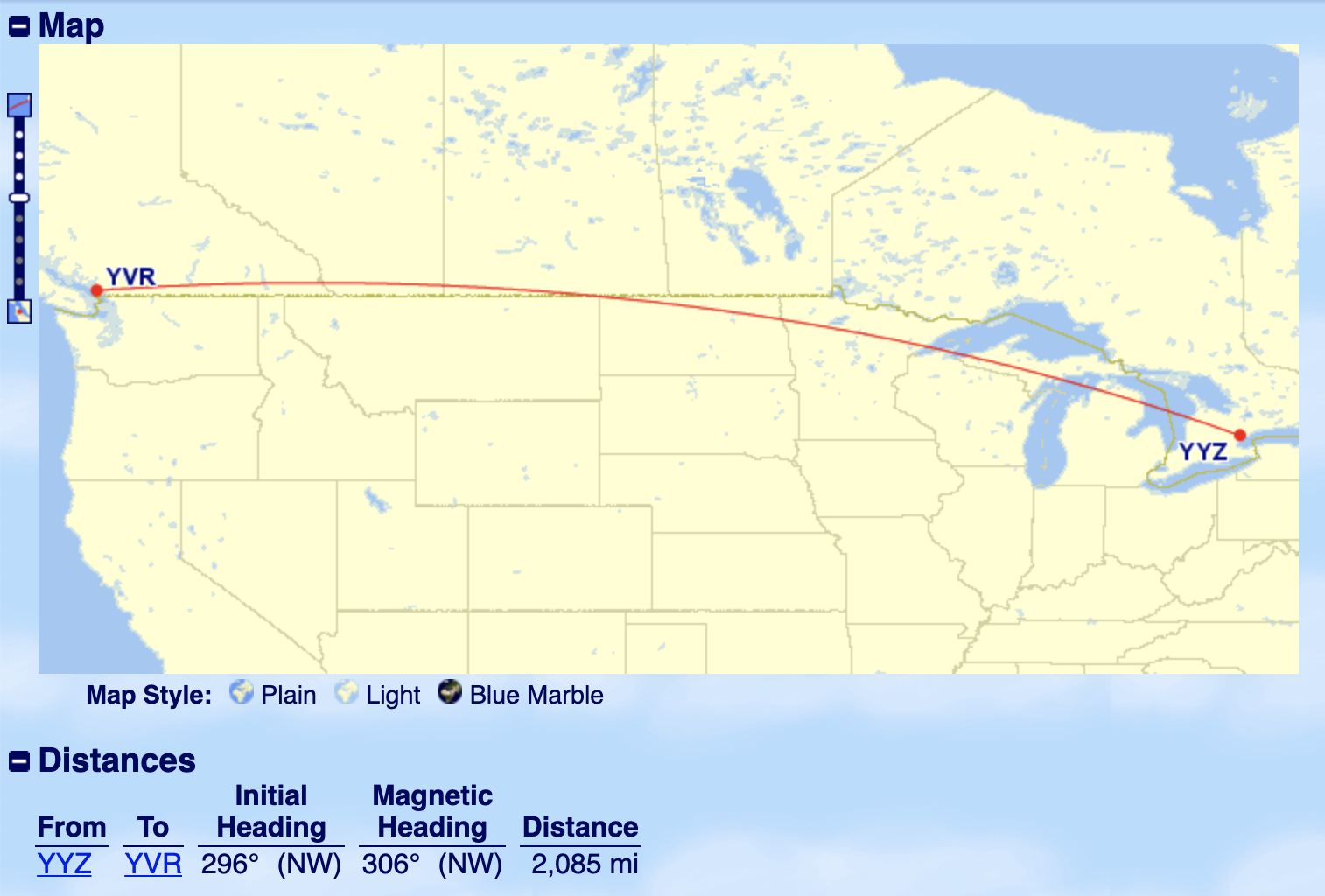 We'd take the "Within North America" chart, look up the distance band of "1,501–2,750 miles", and see that a one-way flight should cost 12,500–17,500 Aeroplan points in economy class, 20,000–35,000 Aeroplan points in premium economy, or 25,000–60,000 Aeroplan points in business class.(Keep in mind that the published ranges for Air Canada flights are meant to be an estimate of 80% of flight results based on the dynamic pricing model. The pricing may also go below or above this range, and if you have Aeroplan Elite Status or a co-branded credit card, then you'll enjoy discounts on the pricing thanks to the preferred pricing feature.)Now, you might be wondering: What about when there's a connection or a stopover along the way? How exactly is the distance calculated? The answer is as follows:
We'd take the "Within North America" chart, look up the distance band of "1,501–2,750 miles", and see that a one-way flight should cost 12,500–17,500 Aeroplan points in economy class, 20,000–35,000 Aeroplan points in premium economy, or 25,000–60,000 Aeroplan points in business class.(Keep in mind that the published ranges for Air Canada flights are meant to be an estimate of 80% of flight results based on the dynamic pricing model. The pricing may also go below or above this range, and if you have Aeroplan Elite Status or a co-branded credit card, then you'll enjoy discounts on the pricing thanks to the preferred pricing feature.)Now, you might be wondering: What about when there's a connection or a stopover along the way? How exactly is the distance calculated? The answer is as follows:
- If the itinerary consists only of Air Canada flights, then the distance is calculated based on the direct distance between origin and destination.
- If the itinerary consists of a partner-operated flight, then the distance is calculated based on the total distance flown.
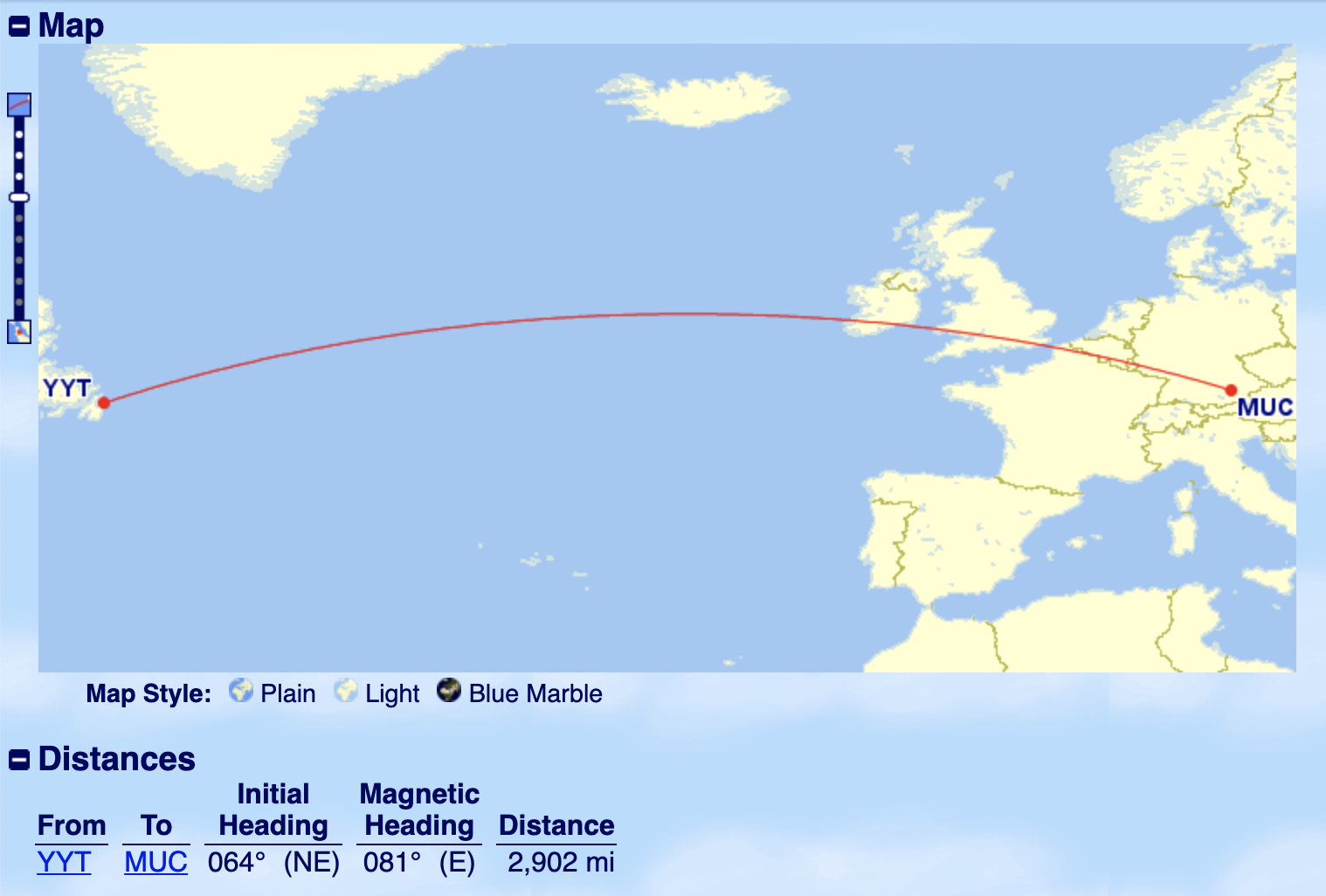 However, in practice, booking St. John's–Munich generally requires backtracking to a hub airport, such as Montreal, in order to catch the transatlantic flight.
However, in practice, booking St. John's–Munich generally requires backtracking to a hub airport, such as Montreal, in order to catch the transatlantic flight.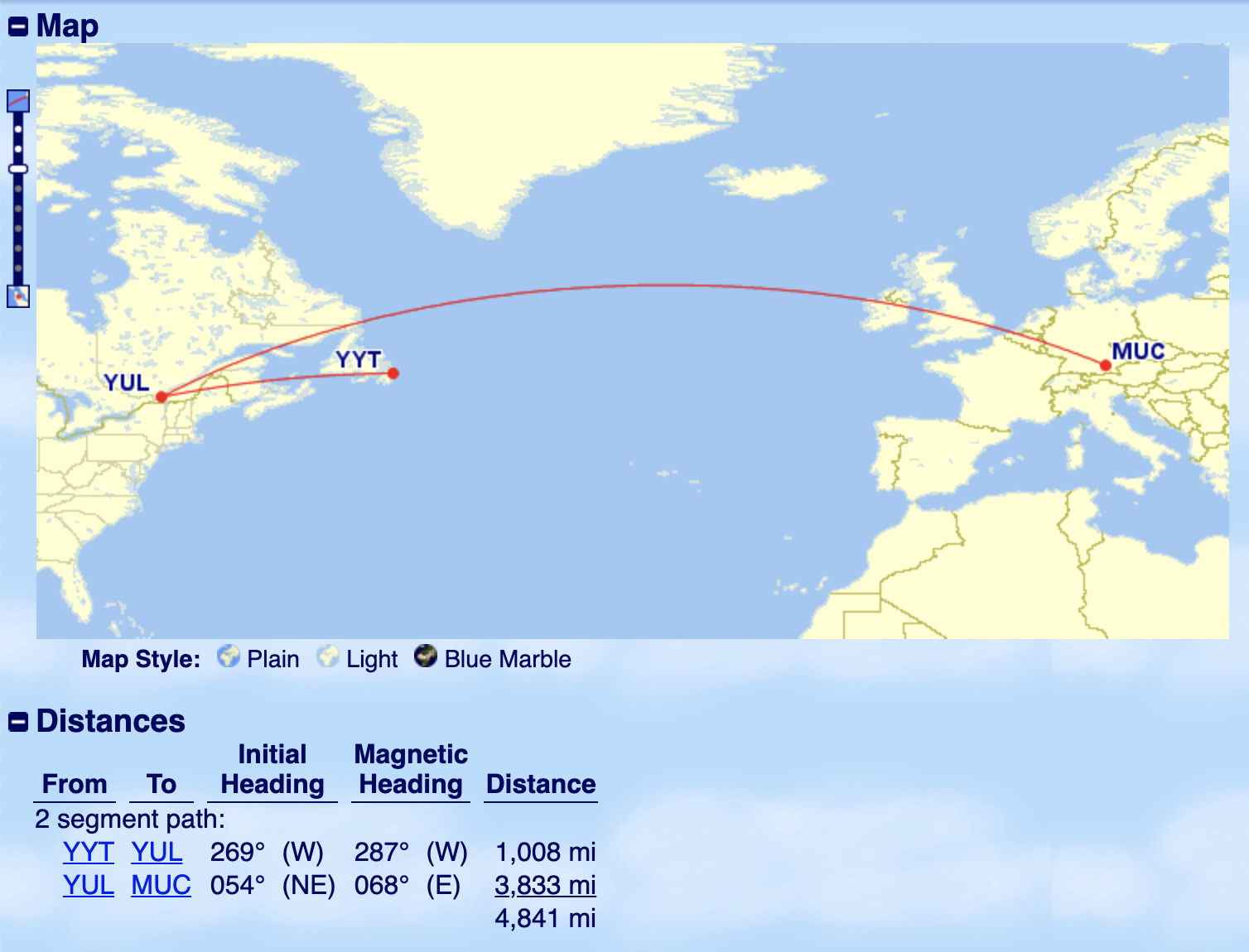 If this transatlantic flight is operated by Air Canada, then scenario #1 above applies.The pricing is calculated based on the direct distance between St. John's and Munich, so you'll pay the dynamic Air Canada pricing for the first distance band of "0–4,000 miles": 35,000–60,000 Aeroplan points in economy class or 60,000–160,000 Aeroplan points in business class.But if the transatlantic flight is operated by Lufthansa, then scenario #2 above applies, since there is now a partner-operated flight on the ticket.The pricing is calculated based on the total distance flown, so you'd pay the partner pricing for the second distance band of "4,001–6,000 miles": 40,000 Aeroplan points in economy class or 70,000 Aeroplan points in business class (assuming that there's no "weighted average" pricing going on, which we'll discuss next).Indeed, there’s one glaring question that you might ask based on the St. John's–Munich example on a mix of Air Canada and Lufthansa: if Air Canada’s flights are dynamically priced, but partner flights are fixed, how does that price out on one itinerary?The answer is that the price is a weighted average based on the respective distances flown on Air Canada and on partner airlines.Any time you book an Aeroplan reward flight, you have the ability to select one of three different fare categories (Standard, Flex, or Latitude) in economy class, or one of two different fare categories (Lowest or Flexible) in premium economy, business class, or First Class.Within each class of service, the higher fare categories typically command a premium of 8,000–15,000 Aeroplan points per direction, and come with added benefits such as a waiver of change and cancellation fees, Preferred seat selection, checked bags, and prioritized eUpgrade clearance.For example, if you have Aeroplan Elite Status and book an Economy (Latitude) fare, you can confirm an upgrade into business class instantly if you have sufficient eUpgrade credits in your account, whereas an Economy (Standard) economy fare must wait until 4–14 days before the date of departure to confirm an upgrade.Moreover, after choosing your desired flight, class of service, and fare category, you'll be given the choice to pay for your Aeroplan award in one of four different ways under the Points + Cash feature.
If this transatlantic flight is operated by Air Canada, then scenario #1 above applies.The pricing is calculated based on the direct distance between St. John's and Munich, so you'll pay the dynamic Air Canada pricing for the first distance band of "0–4,000 miles": 35,000–60,000 Aeroplan points in economy class or 60,000–160,000 Aeroplan points in business class.But if the transatlantic flight is operated by Lufthansa, then scenario #2 above applies, since there is now a partner-operated flight on the ticket.The pricing is calculated based on the total distance flown, so you'd pay the partner pricing for the second distance band of "4,001–6,000 miles": 40,000 Aeroplan points in economy class or 70,000 Aeroplan points in business class (assuming that there's no "weighted average" pricing going on, which we'll discuss next).Indeed, there’s one glaring question that you might ask based on the St. John's–Munich example on a mix of Air Canada and Lufthansa: if Air Canada’s flights are dynamically priced, but partner flights are fixed, how does that price out on one itinerary?The answer is that the price is a weighted average based on the respective distances flown on Air Canada and on partner airlines.Any time you book an Aeroplan reward flight, you have the ability to select one of three different fare categories (Standard, Flex, or Latitude) in economy class, or one of two different fare categories (Lowest or Flexible) in premium economy, business class, or First Class.Within each class of service, the higher fare categories typically command a premium of 8,000–15,000 Aeroplan points per direction, and come with added benefits such as a waiver of change and cancellation fees, Preferred seat selection, checked bags, and prioritized eUpgrade clearance.For example, if you have Aeroplan Elite Status and book an Economy (Latitude) fare, you can confirm an upgrade into business class instantly if you have sufficient eUpgrade credits in your account, whereas an Economy (Standard) economy fare must wait until 4–14 days before the date of departure to confirm an upgrade.Moreover, after choosing your desired flight, class of service, and fare category, you'll be given the choice to pay for your Aeroplan award in one of four different ways under the Points + Cash feature. You can pay the default number of points along with the standard taxes and fees, or you can pay for the whole thing with Aeroplan points (i.e., essentially redeeming additional points to avoid paying the taxes and fees), or pay only 60% of the award with Aeroplan points and the remainder with a cash co-pay (i.e., essentially buying back your points and saving them for a future trip).First of all, paying for the whole thing with points is almost never a good deal – you're essentially redeeming Aeroplan points for 1cpp, which is a very poor redemption value.But currently, Aeroplan lets you "buy back" 40% of your points at an effective rate of 1.9cpp (CAD). Since it's generally pretty feasible to unlock a higher redemption value than 1.9cpp, it can sometimes be a good idea to take advantage of this end of the Points + Cash spectrum and save your points for future high-value uses instead.Finally, remember that you won't have to pay fuel surcharges under the Aeroplan program, regardless of the chosen airline. However, you'll pay a $39 partner booking fee for any ticket that contains at least one flight on a partner airline, and there's also a $30 phone booking fee for any ticket booked over the phone.To learn more about Aeroplan's flight rewards and see how everything plays out on the online search engine, you can watch the below YouTube video that walks you through everything in live-action:
You can pay the default number of points along with the standard taxes and fees, or you can pay for the whole thing with Aeroplan points (i.e., essentially redeeming additional points to avoid paying the taxes and fees), or pay only 60% of the award with Aeroplan points and the remainder with a cash co-pay (i.e., essentially buying back your points and saving them for a future trip).First of all, paying for the whole thing with points is almost never a good deal – you're essentially redeeming Aeroplan points for 1cpp, which is a very poor redemption value.But currently, Aeroplan lets you "buy back" 40% of your points at an effective rate of 1.9cpp (CAD). Since it's generally pretty feasible to unlock a higher redemption value than 1.9cpp, it can sometimes be a good idea to take advantage of this end of the Points + Cash spectrum and save your points for future high-value uses instead.Finally, remember that you won't have to pay fuel surcharges under the Aeroplan program, regardless of the chosen airline. However, you'll pay a $39 partner booking fee for any ticket that contains at least one flight on a partner airline, and there's also a $30 phone booking fee for any ticket booked over the phone.To learn more about Aeroplan's flight rewards and see how everything plays out on the online search engine, you can watch the below YouTube video that walks you through everything in live-action:Award Chart Sweet Spots
Let's talk about some of the best sweet spots for redeeming your Aeroplan points.Generally speaking, business class and First Class flights to international destinations usually offer the best value redemptions – but that’s not to say that redemptions in economy class can never be good value.Using points for last-minute economy tickets, for example, could be extremely valuable since cash fares are likely sky-high. This is especially the case with partner airlines, since award pricing is fixed and predictable.And some people simply don’t care for luxury travel, preferring to use their points to take more trips in coach instead – fair play to them as well.Because the Aeroplan program uses zonal and distance-based charts, the best sweet spots will vary depending on where in Canada or the United States you're originating from.If you're based on the West Coast, then one of the best sweet spots is flying Vancouver–Tokyo (on Air Canada or ANA) for only 35,000 Aeroplan points in economy class or 55,000 Aeroplan points in business class.Due to the geographical proximity to Asia, redemptions under the Pacific chart tend to be more favourable than going to Europe.On the other hand, if you're based in Toronto or Montreal, then the redemption rates to Europe would be relatively more favourable than going to Asia.For example, 60,000 Aeroplan points (or often fewer, thanks to Air Canada's preferred pricing if you hold Aeroplan Elite Status or a co-branded credit card) would unlock a transatlantic flight to most parts of Western Europe.No matter where in Canada you originate from, the "7,501–11,000 miles" distance band on the "Between North America and Pacific zones" chart is a very interesting sweet spot, because it lets you fly a relatively very long distance for only 87,500 Aeroplan points in business class – it's one of the best distance-to-price ratios of the entire chart, and 11,000 miles is often enough to route through Europe or the Middle East on your way to Asia!There are also sweet spots closer to home: short-haul flights within North America that are under 500 miles only cost 6,000 Aeroplan points one-way.Here is a Great Circle Mapper depiction of select major cities that are within 500 miles of Vancouver, Calgary, Toronto, Montreal, and Halifax. You'll note that there are several places you could fly to within each band for only 6,000 points one-way.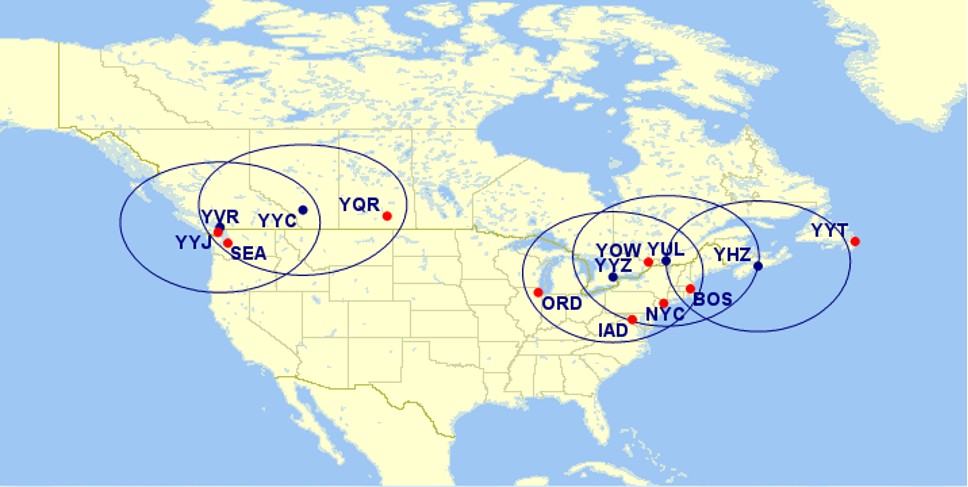 Another very satisfying sweet spot is Hawaii being barely within 2,750 miles of Vancouver, falling just within the third distance band of the "Within North America" chart and costing a mere 12,500 Aeroplan points one-way in economy class at the lower bound of Air Canada's published range.
Another very satisfying sweet spot is Hawaii being barely within 2,750 miles of Vancouver, falling just within the third distance band of the "Within North America" chart and costing a mere 12,500 Aeroplan points one-way in economy class at the lower bound of Air Canada's published range.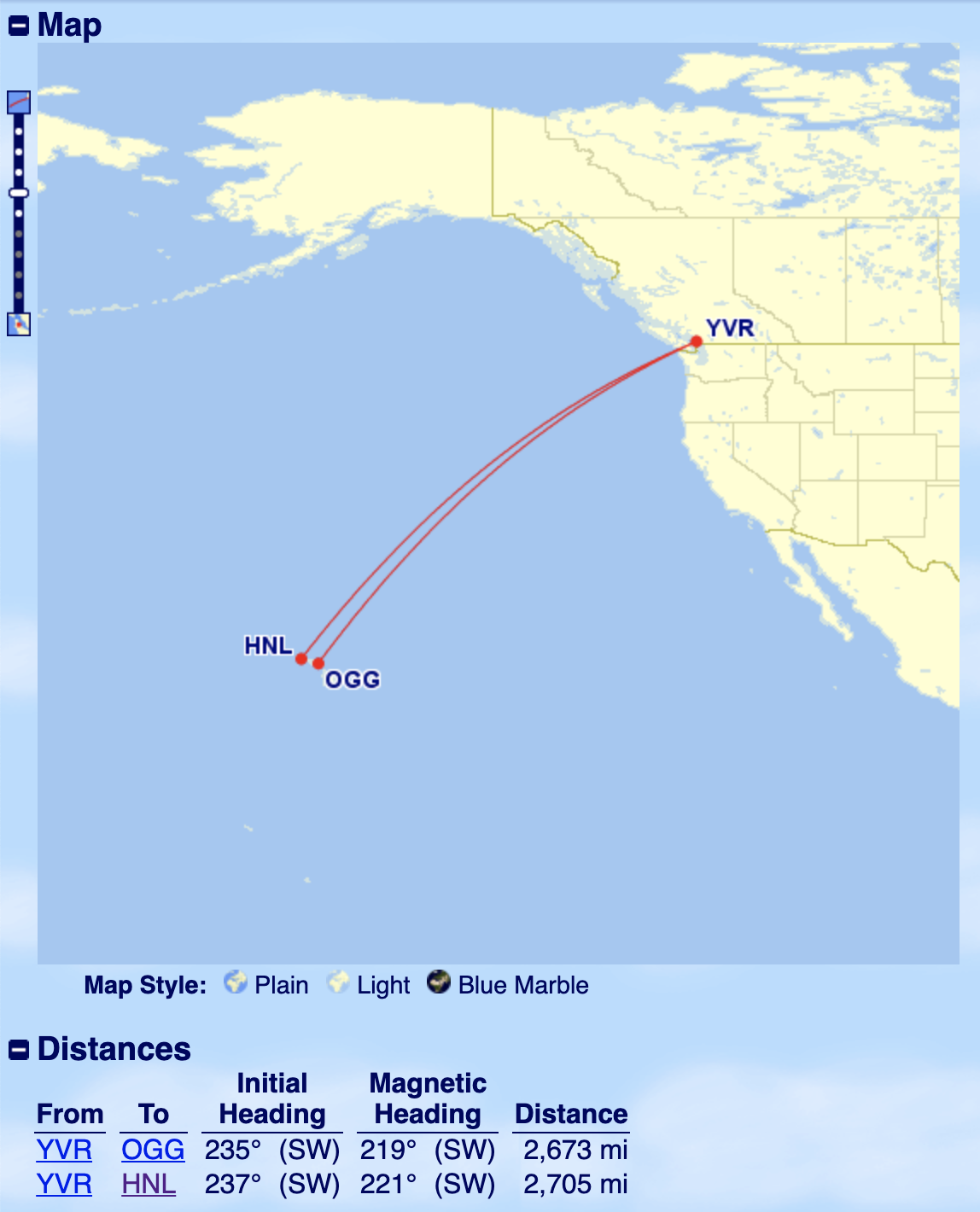 In summary, here's a list of some of Aeroplan's best sweet spots and most favourable redemptions:
In summary, here's a list of some of Aeroplan's best sweet spots and most favourable redemptions:
- Short-haul flights of fewer than 500 miles for 6,000 Aeroplan points in economy class
- Flights of fewer than 1,500 miles (i.e., Toronto–Halifax, Vancouver–Los Angeles) for 10,000 Aeroplan points in economy class or 20,000 Aeroplan points in business class
- Major Canadians cities to Mexico for 12,500 Aeroplan points in economy class or 25,000 Aeroplan points in business class
- Central & Eastern Canadian cities to the Caribbean for 12,500 Aeroplan points in economy class or 25,000 Aeroplan points in business class
- Vancouver to Hawaii for 12,500 Aeroplan points in economy class or 25,000 Aeroplan points in business class
- Rest of Canada to Hawaii for 17,500 Aeroplan points in economy class or 35,000 Aeroplan points in business class
- Toronto or Montreal to Casablanca for 35,000 Aeroplan points in economy class or 60,000 Aeroplan points in business class
- Vancouver or Calgary to Tokyo for 35,000 Aeroplan points in economy class or 55,000 Aeroplan points in business class
- Vancouver or Calgary to Auckland for 75,000 Aeroplan points in business class
- Vancouver to Brisbane for 75,000 Aeroplan points in business class
- Central & Eastern Canadian cities to Peru for 50,000 Aeroplan points in business class
- Canada to the "Asia 3" distance band, potentially routing via Europe, for 85,000 Aeroplan points in business class
Complex Multi-City Trips
In addition to simple round-trip and one-way redemptions, one of the most valuable ways of squeezing every drop of value out of your points is by taking advantage of Aeroplan’s generous stopover rules.A stopover is defined as a stop of more than 24 hours in duration on your way from origin to destination. A stopover can be added to a one-way journey for an incremental 5,000 Aeroplan points.On round-trip awards, you can therefore have up to two stopovers – and thus visiting three places in total, the destination plus the two stopovers – for an incremental 10,000 Aeroplan points.In addition to the stopovers, you can also add layovers (i.e., connections of less than 24 hours) to your itinerary, meaning you could visit five, eight, or even ten places all for the price of one.You’d only be allowed to stay more than 24 hours in your chosen stopover(s) and destination cities, but you could in theory schedule 23-hour layovers in the rest, and get an absurd amount of sightseeing under your belt.To illustrate, let's take the following sample itinerary:
- Toronto–Lisbon (layover) on TAP Air Portugal
- Lisbon–Rome (stopover) on TAP Air Portugal
- Rome–Istanbul (layover) on Turkish Airlines
- Istanbul–Bangkok (destination) on Turkish Airlines
- Bangkok–Seoul (stopover) on Thai Airways
- Seoul–New York (layover) on Asiana Airlines
- New York–Toronto on Air Canada

The outbound flights to Bangkok will comprise a single "one-way bound", while the return flights would comprise a second "one-way bound".
Both would be priced under the “Between North America and Pacific zones” chart, and since the respective total flown distances are 10,249 and 9,525 miles, both one-way bounds would cost 87,500 Aeroplan points each.
Add 10,000 Aeroplan points for the two stopovers, and we arrive at a total price of 185,000 Aeroplan points for the journey in total.
Essentially, for around 180,000–200,000 Aeroplan points, you’re allowed to visit three cities around the world on a round-trip award – which is one of the most valuable uses of your Aeroplan points, since it allows you to essentially take three trips in one.There's much more depth to the topic of complex trips like these – including how you can have up to 10+ destinations on the same ticket, and what exactly is meant by a "one-way bound" in the first place.That's beyond the scope of this guide, but we've written an in-depth article covering all the details, which you can consult below.

